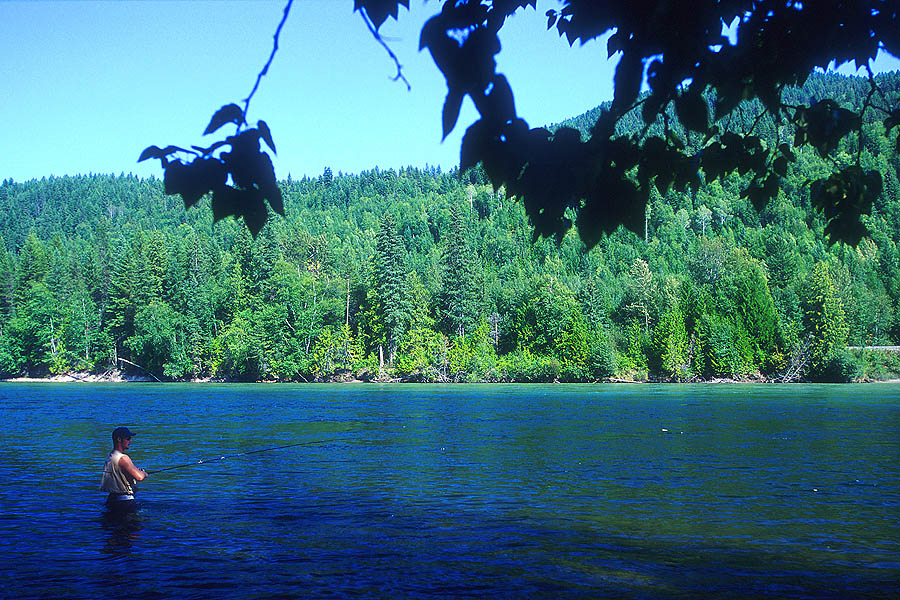 (2001-2004) I believe that Discovery Channel is to blame for my dreams of experiencing thousands of salmon on their spawning run in gin clear rivers – male fish with alien colors, their mouths crooked and teeth pointing in every direction. My dreams came true in Canada, even though I had already fished for king salmon in Alaska, because there is absolutely no comparison to what I experienced in Fraser River, British Columbia.
(2001-2004) I believe that Discovery Channel is to blame for my dreams of experiencing thousands of salmon on their spawning run in gin clear rivers – male fish with alien colors, their mouths crooked and teeth pointing in every direction. My dreams came true in Canada, even though I had already fished for king salmon in Alaska, because there is absolutely no comparison to what I experienced in Fraser River, British Columbia.
Already, the year 2003 had proved the best for king salmon in decades, and when my friends and I went there to fish for white sturgeon (and, of course, salmon), the pink salmon were in the middle of their spawning run. No less than 27 million pink salmon were in the Fraser River system, according to the authorities of British Columbia, so potentially we had a chance to catch ourselves a few salmon…
I fully understand why people get a glazed look in their eyes, when we talk about the different Pacific salmonids – names like chinook, humpie, kokanee, dog, black spring, qualla… believe me, I had serious problems myself when I was introduced to these strange names. It gets easier to understand – and remember – the names of these different salmonid species once you've been there and caught them yourself, but to the rest of the "civilized world" the mystery remains. This is why we will try and make some sense for you by describing the individual species, their habits and looks.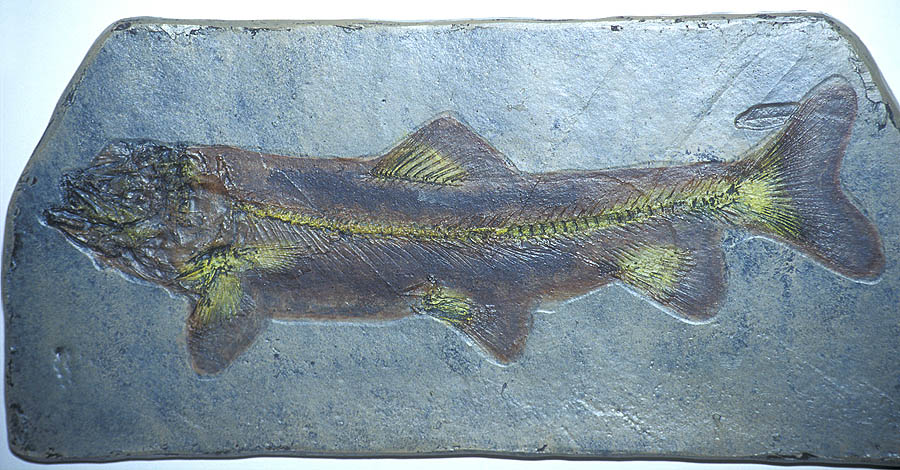
My good friend and travel companion, Thorke, is a biologist - and here are our combined efforts to describe these species:
The Pacific salmon species all belong to the genus Oncorhynchus, which directly translated means "crooked snout", a name you will fully understand once you've come across a male fish in spawning dress. In the 1980's the scientists moved the rainbow trout, and other trout species, to this genus; however, several scientists believe that these trout should have their own "sub-genus" (a sort of "Pacific trout genus").
All Pacific salmon die after spawning, which is a biological adaptation to the low nutritional level of the rivers in the North Pacific region: this way, all the nourishment the adult salmon have accumulated in their bodies, gets transported from the ocean to the rivers, and it sustains the juvenile salmon during the first months of their lives.
Like our own trout species, the various Pacific trout don't necessarily die after spawning.
In the Fraser River and in the North Pacific Ocean at British Columbia you can find the following species of salmon, trout and char:
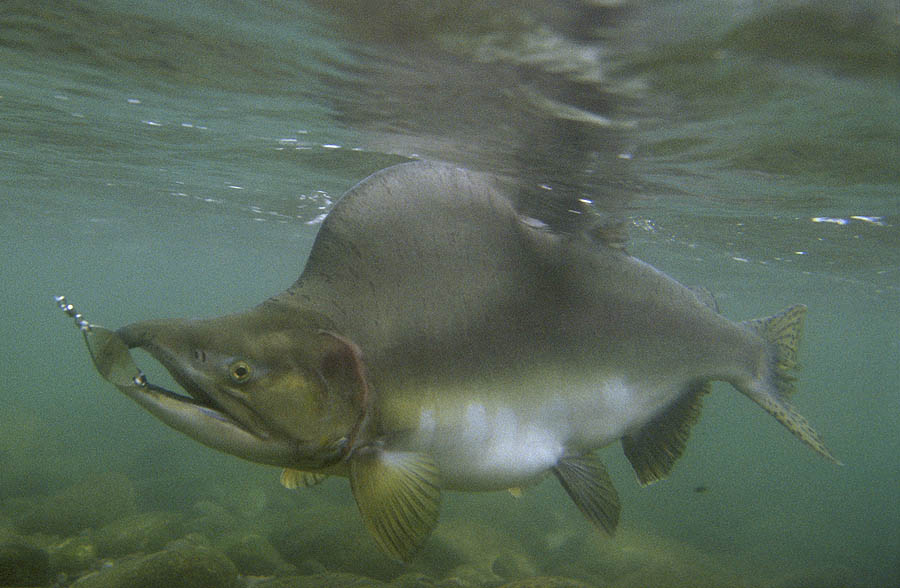 Pink salmon (Oncorhynchus gorbuscha) also called Humpback salmon, Humpy and Humpie.
Pink salmon (Oncorhynchus gorbuscha) also called Humpback salmon, Humpy and Humpie.
This species has large oval spots on its back, tail and the small scales. Spawning males develop a humpback and a seriously crooked mouth with "fangs", and both the male and female get a pink or brown band along the sideline, with a greenish back and white belly.
The pink salmon is found in all of British Columbia, and it runs in the Fraser River system every second year (on odd years) from September through November. The reason for this special two-year appearance is due to the fact that the pinks migrate to the sea the same year they are born and return to the rivers 1½ years later, so in most of the rivers there are 2 genetically separate strains. A local "catastrophe" can therefore wipe out one of the strains, and they will only show up every second year. They are normally caught from 5-12 lbs/2-5½ kg, up to 15 lbs/7 kg/76 cm. (IGFA all-tackle world record: 6.74 kg/14 lb 13 oz).
Locally, the pink salmon is reckoned amongst the least tasty of the Pacific salmon, but our own experience says otherwise.
 Chum salmon (Oncorhynchus keta) also known as Dog salmon, Keta salmon, Calico salmon, Fall salmon and Qualla.
Chum salmon (Oncorhynchus keta) also known as Dog salmon, Keta salmon, Calico salmon, Fall salmon and Qualla.
In the ocean, this species shows no spots on its back and caudal fin. It has silvery lines along the rays of the fins, and it has black tips on its anal-, pelvic- and pectoral fins. Spawning males develop a crooked mouth and large, "unruly" teeth, which is why they're also called "dogs". Spawning males and females have olive-green bodies with dark bars, and develop white tips on anal- and pelvic fins.
The chum salmon can be found in all of British Columbia, and it runs in the Fraser River system from September through December. They are normally caught from 10-13 lbs/4½-6 kg/, up to 35 lbs/16 kg/102 cm. There are reports of chums to 45lbs/20½ kg. (IGFA all-tackle world record: 15.87 kg/35 lb 0 oz).
Locally, this species isn't reckoned as worth eating either, which is why you will often find many of these hard fighting salmon in the rivers.
 Coho salmon (Oncorhynchus kisutch) also known as Silver salmon, Hooknose, White salmon, Hoopid salmon and Silverside.
Coho salmon (Oncorhynchus kisutch) also known as Silver salmon, Hooknose, White salmon, Hoopid salmon and Silverside.
This species has a white gum line on the lower jaw, black tongue, and spots on the back and upper part of the caudal fin. Spawning males develop a greenish tinge on the body and red flanks, whereas the females become bronze colored and pink on the sides.
The coho is found in all of British Columbia, and in the Fraser River system it runs from August through January. It is normally caught from 3½-30 lbs/1½-14 kg, up to 33 lbs/15 kg/108 cm. (IGFA all-tackle world record: 15.08 kg/33 lb 4 oz).
The coho is reckoned to be the wildest fighting of the Pacific salmon, making long runs and always jumping spectacularly. The meat is very tasty, but turns bad quickly after capture.
 Sockeye salmon (Oncorhynchus nerka) also known as Indian salmon, Red salmon, Blueback salmon and Yank. A small and common freshwater form of this species is known as Kokanee, Little redfish, Silver trout, Landlocked Sockeye and Kennerly's salmon.
Sockeye salmon (Oncorhynchus nerka) also known as Indian salmon, Red salmon, Blueback salmon and Yank. A small and common freshwater form of this species is known as Kokanee, Little redfish, Silver trout, Landlocked Sockeye and Kennerly's salmon.
In the ocean this species is recognizable by its relatively large scales, no spots on the tailfin and black stripes along the fin rays. The back is usually without spots, but it can show black dots, and the teeth are small. Spawning sockeye develop a very spectacular look with a dark red body, and green head with a white lower jaw. The males develop a big crooked mouth with "fangs", like the pink salmon.
This species is found in all of British Columbia, and in the Fraser River system it runs from June through November. It is normally caught from 5-9 lbs/2½-4 kg, up to 17 lbs/8 kg/84 cm. Kokanee are normally caught from 1- 4 lbs/½-1½ kg, up to 10 lbs/4½ kg. (IGFA all-tackle world records - Sockeye: 6.88 kg/15 lb 3 oz - Kokanee: 4.27 kg/9 lb 6 oz).
The sockeye is reckoned to be the best of the Pacific salmon for eating, which is why they are fished for so vigorously.
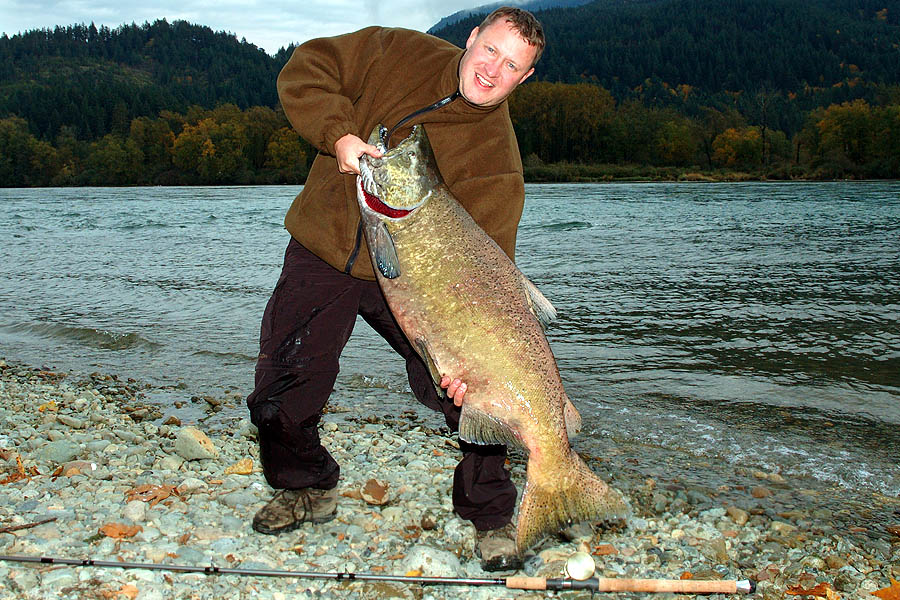 King salmon (Oncorhynchus tshawytscha) also known as Chinook salmon, Quinnat salmon, Red spring salmon, White spring salmon, Blackmouth salmon, Chub salmon, Smilie and Hookbill. Specimens of more than 30 lbs are called Tyee salmon. Some of the king salmon don't migrate; they remain in the rivers and feed primarily on roe – even roe from of their own species. This type is called a Jack.
King salmon (Oncorhynchus tshawytscha) also known as Chinook salmon, Quinnat salmon, Red spring salmon, White spring salmon, Blackmouth salmon, Chub salmon, Smilie and Hookbill. Specimens of more than 30 lbs are called Tyee salmon. Some of the king salmon don't migrate; they remain in the rivers and feed primarily on roe – even roe from of their own species. This type is called a Jack.
The king salmon has black gums and big black spots on the dorsal- and caudal fin. Spawning fish turn dark brown, the males sometimes dark red.
This species is also found in all of British Columbia, and it runs in the Fraser River system from April through November. It is normally caught from 4-65 lbs/1½-30 kg, up to 135 lbs/61½ kg/150 cm, being the biggest of the Pacific salmon. (IGFA all-tackle world record: 44.11 kg/97 lb 4 oz). Because of its size, it is much prized.
The following salmon- and trout species are also found in British Columbia:
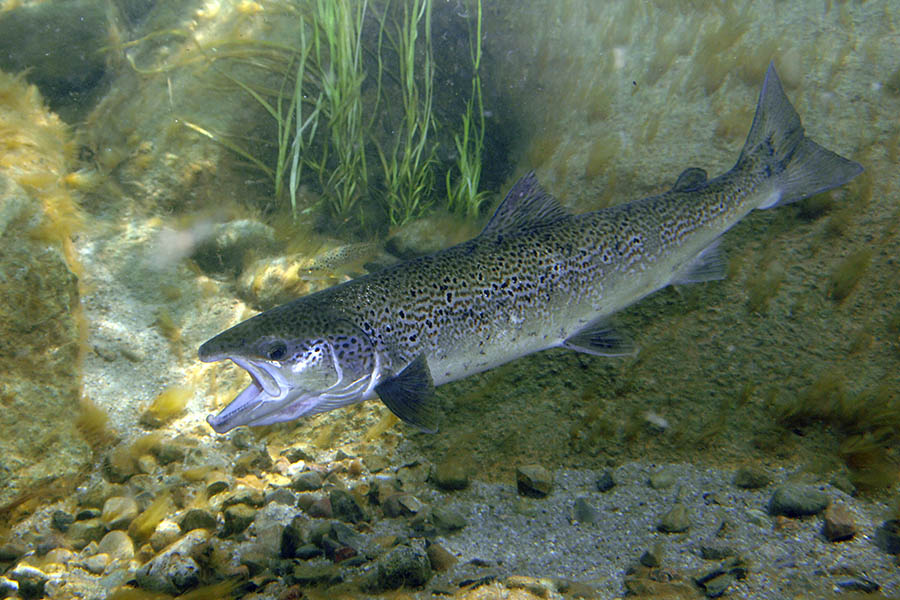 Atlantic salmon (Salmo salar).
Atlantic salmon (Salmo salar).
The Atlantic salmon has recently escaped from offshore fish farms and is considered a threat to the native Pacific salmon populations.
This species has x-shaped spots on the back, 2-3 big black spots on the gill-covers, and no spots on the caudal fin. Spawning fish have a bronze-brown body, usually with red markings.
The Atlantic salmon are caught in the Fraser River system to 7-15 lbs/3-6 kg – although they are recorded to over 100lbs/47 kg/150 cm. (IGFA all-tackle world record: 35.89 kg/79 lb 2 oz).
Trout (Salmo trutta) depending on habitat it is called Sea-, or Brown trout. In Europe we call the lake FORM Lake trout, but in America the name Lake trout is mostly used in association with Canadian lake trout (Salvelinus namaycush).
This trout has many small spots on the gill covers, black spots on the body, but no spots on the caudal fin. The rivers forms also have red spots on the flanks, whilst the lake bound fish tend to become more silvery. Spawning fish become olive-green to brown with black spots.
This species was introduced into lakes and streams in British Columbia. The normal maximum size is 40 lbs/18 kg/103 cm, but specimens of over 110 lbs/50 kg/140cm have been reported. (IGFA all-tackle world record: 18.25 kg/40 lb 4 oz).
 Rainbow trout (Oncorhynchus mykiss) the sea-running form is called Steelhead. It is also known as Hardhead, Ironhead, Metalhead, Silver trout and Gairdner's salmon. Fish remaining in freshwater all their life, are often called Kamloops trout.
Rainbow trout (Oncorhynchus mykiss) the sea-running form is called Steelhead. It is also known as Hardhead, Ironhead, Metalhead, Silver trout and Gairdner's salmon. Fish remaining in freshwater all their life, are often called Kamloops trout.
This species has small spots covering the head, back and the caudal fin. The freshwater form and spawning fish have the familiar broad red band along the sideline, which is often difficult to see in the ocean.
The rainbow trout/steelhead is found in all of British Columbia, and in the Fraser River system it is present all year. It is normally caught from 5-22 lbs/2½-10 kg, up to 55 lbs/25½ kg/120 cm. (IGFA all-tackle world record: 19.10 kg/42 lb 4 oz).
The sea-running form is mostly fished in winter, and is very popular because of its fighting qualities.
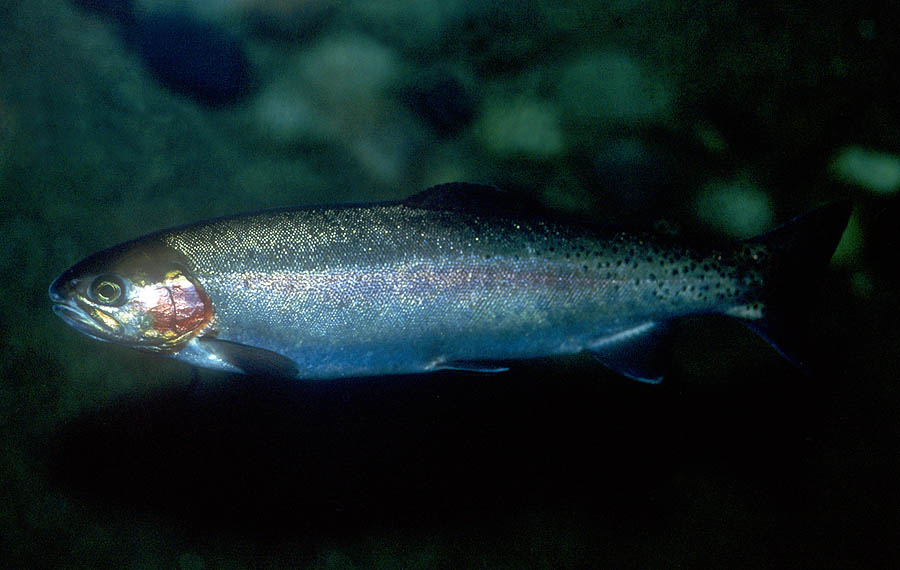 Cutthroat trout (Oncorhynchus clarki) also known as Clark's trout and Redthroated trout.
Cutthroat trout (Oncorhynchus clarki) also known as Clark's trout and Redthroated trout.
In Canada there are two subspecies: Coastal cutthroat trout (Oncorhynchus clarki clarki), which often migrates to saltwater, and West slope cutthroat (Oncorhynchus clarki lewisi), which remains in freshwater all its life.
The cutthroat look much like a rainbow trout with spots covering the whole body, and it has two distinct red stripes on base of its lower jaws ("cutthroat"). These red stripes can be difficult to distinguish on the saltwater form, where the freshwater form often has less spots.
The cutthroat is found along the coastline and in several rivers of British Columbia. It is normally caught up to 17 lbs/8 kg/76 cm, but can reach a size of 41 lbs/18½ kg/99 cm. (IGFA all-tackle world record: 18.59 kg/41 lb 0 oz).
When you compare for size, the cutthroat is relatively the best fighting salmonid in the area. On the coast, this fish holds high status, especially amongst fly fishermen.
Golden trout (Oncorhynchus aguabonita).
This species is possibly "just" a sub species of rainbow trout, and it is only found in freshwater.
It is known for its fantastic golden and red colors. The adult fish keeps the big red juvenile spots along its sides, and develops white tips on the ventral- and anal fins.
The golden trout is introduced into the lower part of Fraser River, and can grow to 11 lbs/5 kg/71 cm. (IGFA all-tackle world record: 4.98 kg/11 lb 0 oz).
The following species belong to the genus Salvelinus, chars or charrs. Historically, several of these species were considered belonging to the same family as the "true trout", and therefore some of them have "trout" incorporated in their common names. Because these names have been used widely for a long time, it is probably difficult for their correct names to be used much.
The chars differ from the trout by having white edges on their pectoral, ventral and anal fins, and they have comparatively smaller scales.
Dolly Varden (Salvelinus malma) also known as Red spotted charr, Pacific brook trout and Pacific brook charr.
This species has small white spots on the back and flanks. Spawning Dolly Varden and the freshwater form are very colorful with yellow, orange and red spots.
Dolly Varden is found along the coastline and in several rivers in British Columbia. It is normally caught from 1-3½ lbs/½-1½ kg, and up to 8 lbs/3½ kg in freshwater. The largest reported specimen weighed over 40 lbs/18 kg/127 cm. (IGFA all-tackle world record: 9.46 kg/20 lb 14 oz). The biggest of these fish are most probably not Dolly Varden, but rather the closely related bull trout (see Bull trout, next).
Previously, the Dolly Varden was exterminated in certain areas, as it was believed that they ate the roe and hatchlings of the sockeye salmon. Fortunately, the Dolly Varden is no longer unpopular, both because it has become of interest to the sport fishermen, and because it was found that the coho was actually worse, when it came to eating the sockeye.
 Bull trout (Salvelinus confluentus) also known as Bull charr.
Bull trout (Salvelinus confluentus) also known as Bull charr.
This species looks a lot like Dolly Varden, and was for a long time thought to be the same species. The bull trout has a more slender body, wider and flatter head, and bigger mouth. Bull trout almost never migrate to saltwater.
This species is found mainly in mountain rivers and –lakes, for example tributaries to the Fraser River. It is caught from 32 lbs/14½ kg/103 cm. (IGFA all-tackle world record: 14.51 kg/32 lb 0 oz).
 Brook trout (Salvelinus fontinalis) also known as Brook charr, Speckled trout/charr, Mountain trout, Humpbacked trout, Mud trout, Native trout, Lord-fish, Baiser, Whitetail and Squaretailed trout. An unspotted variant is called Aurora trout, where the saltwater form is called Salter, Coaster and Slob.
Brook trout (Salvelinus fontinalis) also known as Brook charr, Speckled trout/charr, Mountain trout, Humpbacked trout, Mud trout, Native trout, Lord-fish, Baiser, Whitetail and Squaretailed trout. An unspotted variant is called Aurora trout, where the saltwater form is called Salter, Coaster and Slob.
This species has a greenish net-pattern on the back and dorsal fin, as well as red spots with blue rings on the body. In saltwater the fish has dark green on the back, silvery on the flanks, and it has pink spots.
The brook trout was introduced to British Columbia –into the lower and middle parts of the Fraser River.
It can reach a weight of more than 20 lbs/9 kg/86 cm, but normally it is caught a lot smaller. (IGFA all-tackle world record: 6.57 kg/14 lb 8 oz). It is highly valued by sport fishermen, especially on dry fly.
 Arctic char (Salvelinus alpinus) also known as Arctic charr or just Charr/char, and Alpine charr.
Arctic char (Salvelinus alpinus) also known as Arctic charr or just Charr/char, and Alpine charr.
This species has big white to red spots on the back and flanks, both in salt- & freshwater. Spawning fish develop beautiful colors with greenish back and white, yellow, orange or red flanks and belly.
Arctic char are rarely found in British Columbia, but further north it is much more prolific. It can grow to 33 lbs/15 kg/107 cm. (IGFA all-tackle world record: 14.77 kg/32 lb 9 oz).
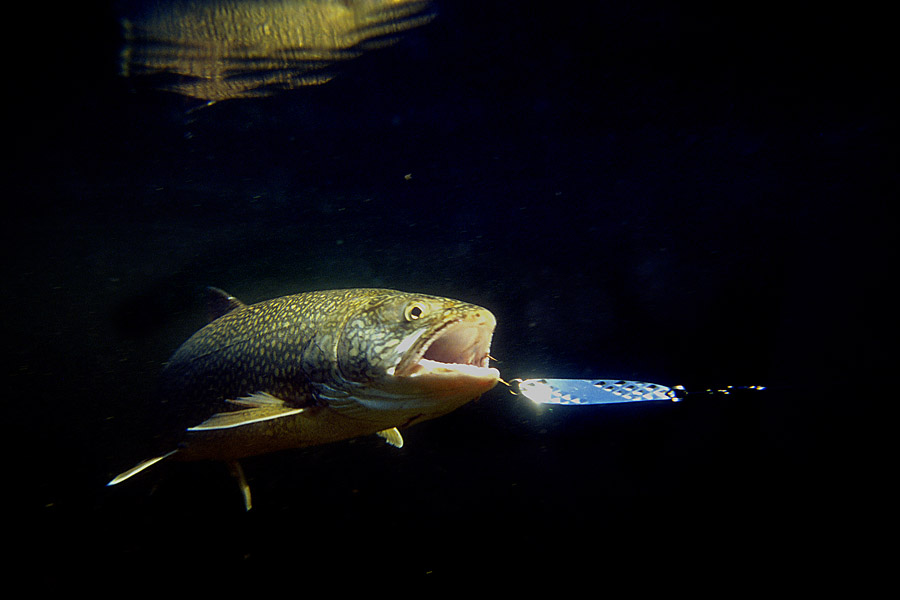 Canadian lake trout (Salvelinus namaycush) also known as Great lake(s) trout/charr, Forktail trout, Laker, Mountain trout, Mackinaw trout, Masamacush, Namaycush, Togue, Taque, Touladi and Grey trout. A fat type of this species is called Siscowet, Siscoet, or just Fat. Two other types are called Lean and Humper, Bumper, Paperbelly or Bank Trout.
Canadian lake trout (Salvelinus namaycush) also known as Great lake(s) trout/charr, Forktail trout, Laker, Mountain trout, Mackinaw trout, Masamacush, Namaycush, Togue, Taque, Touladi and Grey trout. A fat type of this species is called Siscowet, Siscoet, or just Fat. Two other types are called Lean and Humper, Bumper, Paperbelly or Bank Trout.
The Canadian lake trout has a deeply v-shaped cut in the caudal fin. The color is greenish with myriad of spots/markings on the body, head, caudal- and dorsal fin. It never enters saltwater.
It can be found in many lakes in British Columbia, and can grow to 100 lbs/46 kg/150 cm, being to second the largest of the salmonid species in the area. (IGFA all-tackle world record: 32.65 kg/72 lb 0 oz).
It isa very popular species to ice fish for, and understandably so - who wouldn't want to pull a 70 lbs/30 kg fish out of a hole in the ice?
Splake (Salvelinus fontinalis x Salvelinus namaycush) this cross between Brook trout and Canadian lake trout is also known as Wendigo and Moulac.
The splake is found widely in North America, including Canada, because of its sporting qualities, because it grows fast, and it can adapt to conditions, in which the "parent fish" cannot survive. As opposed to other hybrids, the splake is not sterile.
This species has a greenish body color with light spots, a greenish net-pattern on the back, dorsal- and caudal fin. The caudal also has a v-shaped cut like the Canadian lake trout. The splake can be a bit difficult to distinguish from the "parent fish".
It can grow to over 20 lbs/9 kg/90 cm. (IGFA all-tackle world record: 9.39 kg/20 lb 11 oz).
.o0o.
We had our sights on pink salmon on our last trip, but as you can see, there can be several salmon species in the rivers at any one time. Besides pinks, we caught coho-, chum- and king salmon - and one of our friends was fortunate to land a king salmon of over 40 lbs/20 kg.
In the mountains we also caught rainbow trout in the streams, and kokanee in a lake.
Next year there won't be any pinks running (which is ok), but we'll be setting our goals towards more and bigger of those bloody hard fighting cohos and chums.